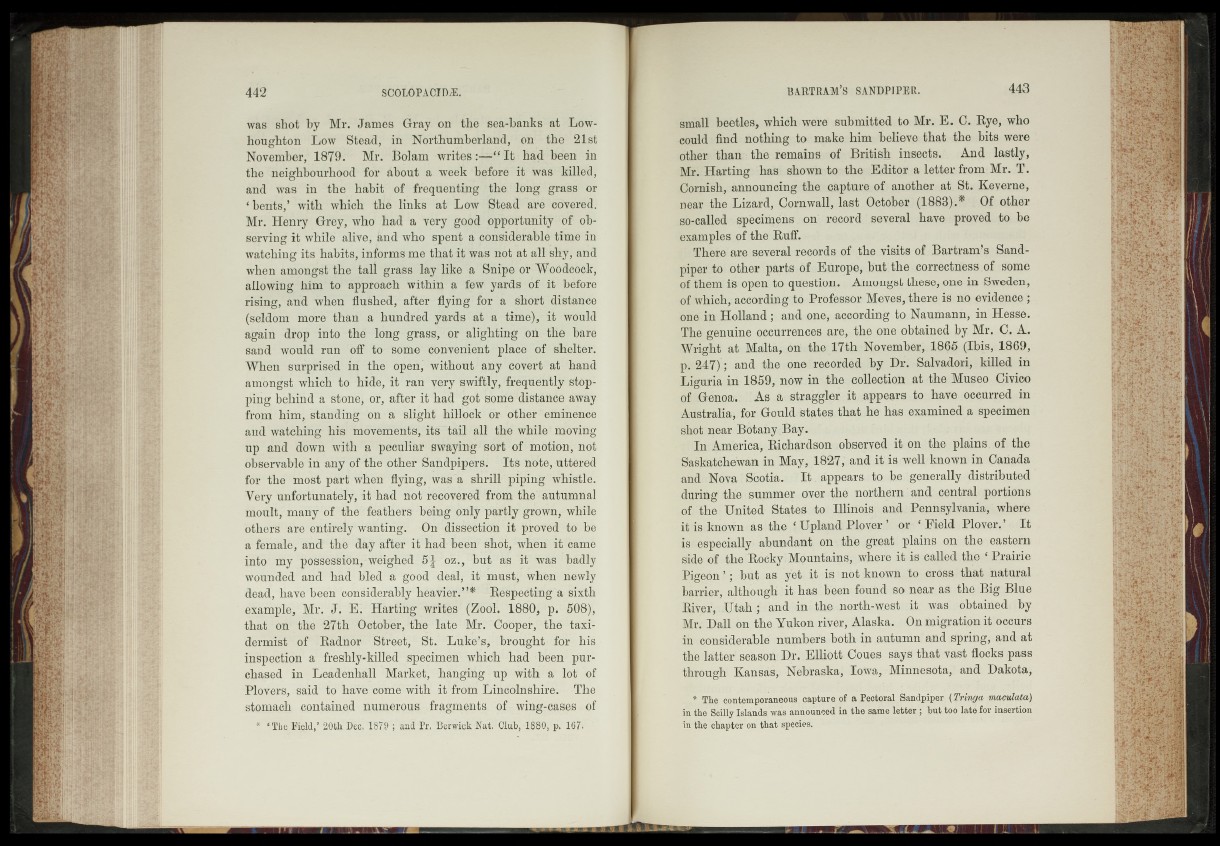
was shot by Mr. James Gray on the sea-banks at Low-
houghton Low Stead, ih Northumberland, on the 21st
November,'1879: ’ Mr. feolam writes 1% had been in
the neighbourhood'for about a week before it was- killed,
and was in the habit of frequenting the long grass or
‘ bents,’ with which tHé links at Low Stead arë covered.
Mr. Henry Grey, who had a very good opportunity ;:of; observing
it while alive, ànd who spent a considerable time in
watching its habits, informs me that it was not at all shy [and
when amongst the tall grass lay Ji]ke a Snipe or Woodcock,
allowing him to approach wit’hih a few yards of' it*' 'before
rising, and when flushed, after flying-for a short distance
(seldom more than a hundred yards at a time), it would
again drop into the long grass, or: alighting Tom the bare
sand would run off to some' convenient placé of- -Shelter.
When surprised in the open, without any‘covert‘at hand
amongst which to hide, it ran very swiftly, Lfrequëntlÿ-stopping
behinda stone) or, after it had got some'distance away
from him, standing on a slight hillock ‘pVotMèr^éfliime'nce
and watching his- Movements, its^tajl all the while ' moving
up and down with a 'ïpdèuliur swaying * sort of motion^ -hot
Observable'in any of the other Sandpipers. Its note, uttered
for the* most part when flying, was'a shrill' piping Whistle.
Very unfortunately, it had hot rfecbveréd :from the -autumnal
moult, many of the feathers- -being only partly grown, while
others’ are entirely-wanting. On- disèefetîtfn'it proved •
a female, andJithe day after ït had’néén* ^ o tj 'whehi'it^a-me
into my-póssè?sMón,-wéigheff^5l^p${,cbut as it: was badly
wounded'and had good deal, it-'must,- when newly
dead, have been considerably heavier.”* feb%ectihg^a>!ixth
example, Mr. J-. ET Harting-writes1 (Zool. 1880, p. 508)’,
that on the 27th -October, thé Tate Mr. "Goóper,''thé taxidermist
of Radnor Street,- St.-^JTuke?s, brought- for hiê
inspection a freshly-killed 'specimen1 Which had been’.purchased
in Leadenhal’l Market; - hanging up-with -' a^ i’éfe of
Tlpvers, said to have come with it from Lincolnshire. -The
stomach contained numerous fragments, of - wing-qaeps -> of
* ‘The Firfd,’ 20thi'I>ec. 1*8^"; and OlubJ4f88'0^p. 1671
small beetles, which were submitted to Mr. E. 0. Rye, who
could find nothing to make him believe that the bits were
other than:-, the remains of British insects. And lastly,
Mr. Harting has shown to; the Editor a letter from; Mr. T.
Cornish, announcing the capture of) another at St. Keverne,
near the Lizard, Cornwall, last October (1883);.* . Of other
so-called specimens on record several have proved to be
examples of the Ruff.
.;: There: are spvera.1 records of the visits of Bartram’s Sandpiper
to other.parts of Europe, but; the -correctness nf some
of them is-opern to question-. Amongst these,.one in Sweden,
of which,-according to P-rofessor Meves, there is no evidence;
one?-in Holland ; and one, according to Naumann, in Hesse.
The genuine occurrences are, the one|pbtained by,Mr, C. A.
Wright afc Malta, on| the 17th|^ovembej:, 1865 (Ibis, 1869,
p. 247)'; and fhe one recorded by Dr. Salvadori, killed in
Liguria in 1-859, now in The collection at the Museo Civico
offeGenoa.. :As a straggler^it appears to have occurredTin
Australia, for Gould.-states that he has examined a specimen
shot'near Botany;Bay.
Mn. America, Richardsomjobserved it on the plains, of the
Saskatchewan in May, 1827,’ and if-is-well-known-in Canada ,
and Nova 1 Scotia.- I t . appears to -be .generally - distributed
during the - summer over the northern, and central portions
of the. United States to Illinois and Pennsylvania, where
it'isiknown- as the Upland Plover | wh ^Field Plover.’ - It
^especially- abundant on- the great, plains tau,The eastern
$de of ThelRocfeylMountains, where if.is called „the/. Prairie
-Mgeen ’ ; but as,' ybtiitris not-.known‘to cross? that natural
barrier, although . it has been found so near as the-Big Blue
RivpiW* Utah-; and in-the morth-westvit; w.as,, obtained * ? by
Mr:; Dali on -the Yukon river;, Alaska... » Op migrationitoccurs
in-/considerable’'.-numbers both ip autumn and spring, and at
the latterTseasoMDr.'.Eliibttjfioues says that-vast flocks pass
through Kansas,- Nebraska,' Iowa, - Minnesota)) and Dakota,
* The contemporaneous capture of a Pectoral Sandpaper; {'fxinga, -maculata)
in the Scilly Islands was announced in the same le tte r; fu t too iateidr insertion
in the chapter-on that species’.' •'